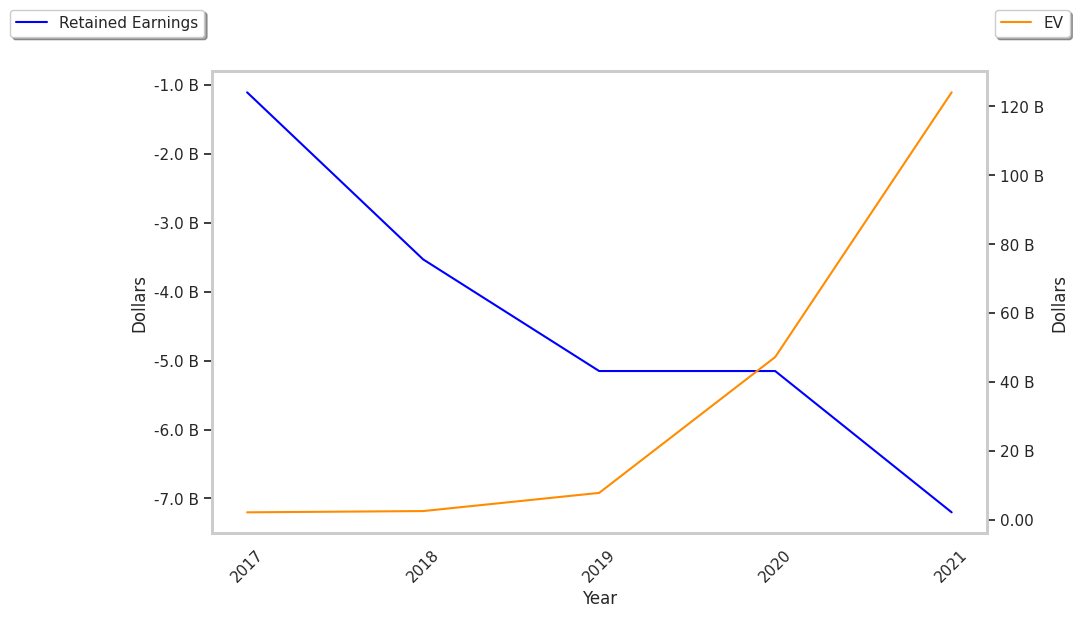Shares of Sea (SE) jumped 3.8 % during today's afternoon session, bringing their 52 week performance to -36.6%. The stock seems to be overvalued in terms of traditional metrics, but in this day in age, we believe that a complete stock analysis should also take into account the company's poor growth indicators and positive market sentiment.
Sea Limited, together with its subsidiaries, engages in the digital entertainment, e-commerce, and digital financial service businesses in Southeast Asia, Latin America, rest of Asia, and internationally. The large-cap Consumer Discretionary company is based in Singapore, Singapore and has 63,800 full time employees.
SE Has a Higher P/E Ratio Than the Sector Average
Compared to the Consumer Discretionary sector's average of 22.96, Sea has a trailing twelve month price to earnings (P/E) ratio of 34.7 and an expected P/E ratio of 700.3. The P/E ratios are calculated by dividing the company's share price by its trailing 12 month of $1.21 or forward earnings per share of $0.06.
Earnings represent the net profits left over after subtracting costs of goods sold, taxes, and operating costs from the company's recorded sales revenue. One way of looking at the P/E ratio is that it represents how much investors are willing to pay for every dollar's worth of the company's earnings. Since Sea's P/E ratio is higher than its sector average of 22.96, we can deduce that the market is overvaluing the company's earnings.
Sea Is Fairly Valued in Terms of Expected Growth
Another factor pointing to Sea's value is its PEG ratio of 1.21. This is the stock's price to earnings ratio divided by its estimated earnings growth rate. If the resulting ratio is near or lower than 1 -- but higher than 0 -- its indicates that the company is faitly valued in terms of expected growth.
SE Has an Alarming P/B Ratio
The price to book (P/B) ratio of a company is a comparison of the company's market capitalization versus its net asset, or book value. A ratio lower than 1 tells you that the equity market is undervaluing the book value of the company's assets, and ratios higher than 1 tell you that the equity markets are overvaluing the company in terms of its assets.
Of course, a company is worth much more than its assets alone, so the focus on P/B ratio is mainly to enable investors to single out undervalued securities that offer a margin of safety. Since Sea's P/B ratio of 3.6 is higher than its sector average of 4.24, such a margin of safety does not exist for the stock.
SE's Weak Cash Flow Generation Is Troubling
The table below shows that Sea is not generating enough cash. A well run company will generally have cash flows that reflect the strength of its underlying business, and in Sea's case, free cash flow is growing at an average rate of -31.7% with a coefficient of variability of 347.93%. We can also see that cash flows from operations are evolving at a -22.9% rate, versus 49.8%:
| Date Reported | Cash Flow from Operations ($ k) | Capital expenditures ($ k) | Free Cash Flow ($ k) | YoY Growth (%) |
|---|---|---|---|---|
| 2022 | -1,055,692 | 924,178 | -1,979,870 | -251.33 |
| 2021 | 208,649 | 772,177 | -563,528 | -356.62 |
| 2020 | 555,868 | 336,274 | 219,594 | 229.19 |
| 2019 | 69,865 | 239,844 | -169,979 | 74.73 |
| 2018 | -495,220 | 177,343 | -672,563 | -105.94 |
| 2017 | -259,228 | 67,361 | -326,589 |
Sea's Is a Profitable Business
If you are looking to make SE a long term investment, it's essential that you understand the viability of its business through a study of its margins. Gross margins tell you how much the company makes in profit when only the costs directly related to producing the goods or delivering the service are taken into account. Operating margins, on the other hand, factor in overhead costs so they tell you how effectively Sea is run.
Sea's Gross Margins
| Date Reported | Revenue ($ k) | Cost of Revenue ($ k) | Gross Margins (%) | YoY Growth (%) |
|---|---|---|---|---|
| 2022 | 12,449,705 | 7,264,428 | 42 | 7.69 |
| 2021 | 9,955,190 | 6,059,455 | 39 | 25.81 |
| 2020 | 4,375,664 | 3,026,759 | 31 | 10.71 |
| 2019 | 2,175,378 | 1,570,458 | 28 | 1300.0 |
| 2018 | 826,968 | 812,210 | 2 | -90.48 |
| 2017 | 414,190 | 326,878 | 21 |
Sea's Operating Margins
| Date Reported | Total Revenue ($ k) | Operating Expenses ($ k) | Operating Margins (%) | YoY Growth (%) |
|---|---|---|---|---|
| 2022 | 12,449,705 | 6,672,785 | -12 | 25.0 |
| 2021 | 9,955,190 | 5,478,795 | -16 | 46.67 |
| 2020 | 4,375,664 | 2,652,230 | -30 | 26.83 |
| 2019 | 2,175,378 | 1,496,152 | -41 | 65.83 |
| 2018 | 826,968 | 1,003,526 | -120 | 0.83 |
| 2017 | 414,190 | 589,668 | -121 |
Sea's cost of revenue is growing at a rate of 66.4% in contrast to 53.0% for operating expenses. Sales revenues, on the other hand, have experienced a 82.2% growth rate. As a result, the average gross margins growth is 29.6 and the average operating margins growth rate is 37.0, with coefficients of variability of 2165.73% and 43.24% respectively.
Sea Benefits From Positive Market Signals
The market sentiment regarding Sea is overwhelmingly positive. The stock has an average rating of buy and target prices ranging from $145.0 to $32.0. SE is trading -25.73% away from its target price of $56.58. 7.6% of the company's shares are tied to short positions, and 55.0% of the shares are held by institutional investors.
| Date Reported | Holder | Percentage | Shares | Value |
|---|---|---|---|---|
| 2023-12-31 | Baillie Gifford and Company | 6% | 34,183,394 | $1,436,386,231 |
| 2023-09-30 | FMR, LLC | 4% | 21,686,487 | $911,266,193 |
| 2023-09-30 | Blackrock Inc. | 3% | 16,212,531 | $681,250,560 |
| 2023-09-30 | Sands Capital Management, LLC | 3% | 16,119,943 | $677,360,012 |
| 2023-09-30 | Tiger Global Management, LLC | 2% | 11,702,820 | $491,752,501 |
| 2023-09-30 | Price (T.Rowe) Associates Inc | 2% | 11,226,560 | $471,740,056 |
| 2023-09-30 | Capital Research Global Investors | 2% | 10,356,685 | $435,187,908 |
| 2023-09-30 | Atreides Management, LP | 1% | 7,084,934 | $297,708,929 |
| 2023-09-30 | State Street Corporation | 1% | 6,299,463 | $264,703,438 |
| 2023-09-30 | Morgan Stanley | 1% | 6,069,772 | $255,051,822 |



